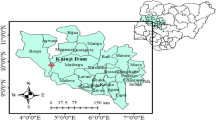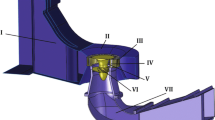Abstract
A neural network (NN)-based nonlinear predictive control (NPC) is described for control of turbine power with variation in gate position. The studied plant includes the tunnel, surge tank and penstock effect dynamics. Multilayer perceptron neural network is chosen to represent a neural network nonlinear autoregressive with exogenous signal model of hydro power plant. With the said NN model configuration, quasi-Newton and Levenberg–Marquardt iterative optimization algorithms are applied in order to determine optimal predictive control parameters. The controlled response is simulated on different amplitude step function and trapezoidal shape reference signal. The study also discusses comparison with an approximate predictive control approach, being linearized around operating points. It is shown that NPC strategy gives impressive results in comparison to the approximated one.










Similar content being viewed by others
Explore related subjects
Discover the latest articles, news and stories from top researchers in related subjects.Abbreviations
- \(\overline {H}_{\rm surge}, \overline {H}_{\rm turbine}\) :
-
head available in riser of surge tank, turbine (p.u.)
- \(\overline {H}_{\rm tunnel}, \overline {H}_{\rm penstock}\) :
-
head loss in tunnel, penstock (p.u.)
- \(\overline {U}_{\rm tunnel}, \overline {U}_{\rm turbine}, \overline {U}_{\rm surge}\) :
-
velocity of water in tunnel, turbine, surge tank (p.u.)
- \(\overline {U}_{\rm no load}\) :
-
velocity of water at no load (p.u.)
- \(f_{\rm tunnel}, f_{\rm penstock}, f_0\) :
-
head loss coefficient in tunnel, penstock, riser (p.u.)
- \(C_{\rm surge}\) :
-
storage constant of surge tank (s)
- \(\overline {H}_{\rm devia,tunnel}\) :
-
head deviation in tunnel (p.u.)
- \(\overline {H}_{\rm devia,penstock}\) :
-
head deviation in penstock (p.u.)
- Z p :
-
hydraulic surge impedance of water in penstock (=T w / T ep )
- T w :
-
water time constant in penstock (s) \(\left( {=\frac{LU_0 }{gH_0}} \right),\) T w varies with load
- T ep :
-
water elastic time in penstock (s)
- T wc :
-
water time constant in tunnel (s)
- T a :
-
mechanical starting time (s)
- L :
-
length of penstock
- U 0 :
-
velocity of water in penstock at rated head (p.u.)
- g :
-
acceleration due to gravity, (m/s 2 )
- H 0 :
-
rated turbine head (p.u.)
- \(\Delta \overline {\omega }\) :
-
deviation of rotor speed (p.u.)
- \(\overline {G}_{\rm opening}\) :
-
gate opening (p.u.)
- D turbine :
-
damping factor or coefficient in p.u. torque/p.u.speed deviation
- A gain :
-
turbine gain
References
Cominos P, Munro N (2002) PID controllers: recent tuning methods and design to specification. IEE Proc Control Theory Appl 149:46–53
Luqing YE, Shouping WEI, Zhaohui LI, Malik OP, Hope GS, Hancock GC (1990) An intelligent self-improving control strategy and its microprocessor-based implementation to a hydro-turbine governing system. Can J Electr Comput Eng 15:130–138
Zhaohui LI, Luqing YE, Shouping WEI, Malik OP, Hope GS, Hancock GC (1991) Field tests with a prototype duplicate microprocessor-based governor for a hydro turbine. IEEE Trans Energy Conversion 6:349–355
Zhaohui LI, Luqing YE, Shouping WEI, Malik OP, Hope GS, Hancock GC (1992) Fault tolerance aspects of a highly reliable microprocessor-based water turbine governor. IEEE Trans Energy Conversion 7:1–7
Zhaohui LI, Malik OP (1997) An orthogonal test approach based control parameter optimization and its application to a hydro-turbine governor. IEEE Trans Energy Conversion 12:388–393
Lansberry JE, Wozniak L (1992) Optimal hydro generator governor tuning with a genetic algorithm. IEEE Trans Energy Conversion 7:623–630
Yamamoto T, Kaneda M, Oki T, Watanabe E, Tanaka K (1995) Intelligent tuning of PID controllers. In: IEEE conference on intelligent systems for 21st century. Proceedings of systems, man and cybernetics, 22–25 October 1995, pp 2610–2615
Cheng Y-C, Ye L-O, Chuang F, Cai W-Y (2002) Anthropomorphic intelligent PID control and its application in hydro turbine governor. In: Proceedings of the 1st international conference on machine learning and cybernetics, 4–5 November 2002, pp 391–395
Kishor N, Saini RP, Singh SP (2005) Small hydro plant identification using NNARX structure. Neural Comput Appl 14:212–222
Constantin N (2003) Adaptive neural predictive techniques for nonlinear control. Stud Inform Control 12:285–291
Nørgaad M, Sørensen PH, Poulsen NK, Ravn O, Hansen LK (1996) Intelligent predictive control of nonlinear processes using neural networks. In: Proceedings of IEEE international symposium on intelligent control, pp 301–306
Quiroga OD (2000) Thesis: modelling and nonlinear control of voltage frequency of hydroelectric power plants. Universidad Politécnica De Cataluña, Spain
Cybenko G (1989) Approximations by superpositions of a sigmoidal function. Math Control Signals Syst 2 2:303–314
Funahashi K (1989) On the approximate realization of continuous mappings by neural networks. Neural Netw 2:183–192
Nørgaard M (2000) Neural network based system identification toolbox, Tech. Report. 00-E-891, Department of Automation, Technical University of Denmark
Nørgaard M, Ravn O, Poulsen NK, Hansen LK (2000) Neural networks for modeling and control of dynamics systems, 1st edn. Springer, London
Author information
Authors and Affiliations
Corresponding author
Rights and permissions
About this article
Cite this article
Kishor, N., Singh, S.P. Nonlinear predictive control for a NNARX hydro plant model. Neural Comput & Applic 16, 101–108 (2007). https://doi.org/10.1007/s00521-006-0043-0
Received:
Accepted:
Published:
Issue Date:
DOI: https://doi.org/10.1007/s00521-006-0043-0




